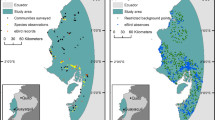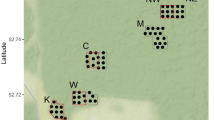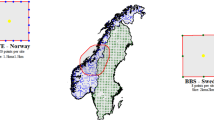Abstract
Assessing the spatial structure of abundance of a species is a basic requirement to carry out adequate conservation strategies. However, existing attempts to predict species abundance, particularly in absolute units and on large scales, are scarce and have led to weak results. In this work we present a scheme to obtain, in an affordable way, a predictive model of absolute animal abundance on large scales based on the modelling of data obtained from local ecological knowledge (LEK) and its calibration. To exemplify this scheme, we build and validate a predictive absolute abundance model of the endangered terrestrial tortoise Testudo graeca in Southeast Iberian Peninsula. For that purpose, we collected distribution and relative abundance data of T. graeca using a low cost methodology, such as LEK, by means of interviewing shepherds. The information from LEK was employed to build a predictive habitat-based model of relative abundance. The relative abundance model was transformed into an absolute abundance model by means of calibration with a classical absolute abundance sampling method such as distance sampling. The obtained absolute abundance model predicted the observed absolute abundances values well in independent locations when compared with other works (R 2 = 36%) and thus can offer a cost-effective predictive ability. Our results show that reliable habitat-based predictive maps of absolute species abundance on regional scales can be obtained starting from low cost sampling methods of relative abundance, such as LEK, and its calibration.



Similar content being viewed by others
References
Anadón JD, Giménez A, Martínez M, Martínez J, Pérez I, Esteve MA (2006a) Factors determining the distribution of the spur-thighed tortoise in south-east Spain: a hierarchical approach. Ecography 29:339–346
Anadón JD, Giménez A, Martínez M, Pérez I, Esteve MA (2006b) Habitat selection of the spur-thighed tortoise in a multisuccesional landscape: implications for habitat management. Biodivers Conserv 15:2287–2299
Anadón JD, Giménez A, Ballestar R, Pérez I (2009) Evaluation of local ecological knowledge as a method for collecting extensive animal abundance data. Conserv Biol 23:617–625
Best LB, Stauffer DF (1986) Factors confunding evaluation of bird-habitat relationships. In: Verner J (ed) Wildlife 2000: modelling habitat relationships of terrestrial vertebrates. University of Wisconsin Press, Madison, pp 209–216
Bock CE, Jones ZF (2004) Avian habitat evaluation: should counting birds count? Front Ecol Environ 8:403–410
Brand LA, Noon BR, Sisk TD (2006) Predicting abundance of desert riparian birds: validation and calibration of the effective area model. Ecol Appl 16:1090–1102
Buckland ST, Anderson DR, Burnham KP, Laake JL, Borchers DL, Thomas L (2001) Introduction to distance sampling: estimating abundance of biological populations. Oxford University Press, Oxford
Burnham KP, Anderson DR (2002) Model selection and Multi-model inference A practical information-theoretic approach. Springer-Verlag, New York.
Cablk ME, Heaton JS (2006) Accuracy and reliability of dogs in surveying for desert tortoise (Gopherus agassizii). Ecol Appl 16:1926–1935
Eberhardt LL, Simmons MA (1987) Calibrating population indices by double sampling. J Wildl Manag 51:665–675
Fielding AH, Bell JF (1997) A review of methods for the assessment of prediction errors in conservation presence/absence models. Environ Conserv 24:38–49
Folke C (2004) Traditional knowledge in social–ecological systems. Ecol Soc 9:7. http://www.ecologyandsociety.org/vol9/iss3/art7/
Goodman LA, Kruskal WH (1954) Measures of association for cross-classifications. J Am Stat Assoc 86:1085–1111
Guisan A, Thuiller W (2005) Predicting species distribution: offering more than simple habitat models. Ecol Lett 8:993–1009
Guisan A, Theurillat J, Kienast F (1998) Predicting the potential distribution of plant species in an alpine environment. J Veg Sci 9:65–74
Gutzwiller KJ, Barrow WC Jr (2001) Bird-landscape relations in the Chihuahuan desert: coping with uncertainties about predictive models. Ecol Appl 11:1517–1532
Huntington HP (1997) Observations on the utility of semi-directive interviewing for documenting traditional ecological knowledge. Arctic 51:237–242
Kays RW, Gompper ME, Ray JC (2008) Landscape ecology of eastern coyotes based on large-scale estimates of abundance. Ecol Appl 18:1014–1027
Liu C, Berry PM, Dawson TP, Pearson RG (2005) Selecting thresholds of occurrence in the prediction of species distributions. Ecography 28:385–393
López-Jurado LF, Talavera PA, Ibáñez JM, Mac Ivor JA, Garcia-Alcázar A (1979) Las tortugas terrestres Testudo graeca y Testudo hermanni en España. Naturalia Hispanica 17. ICONA, Madrid
McCullagh P, Nelder JA (1983) Generalised linear modelling. Chapman and Hall, London
Meggs JF, Munks SA, Corkrey R, Richards K (2004) Development and evaluation of predictive habitat models to assist the conservation planning of a threatened lucanid beetle Hoplogonus simsoni in north-east Tasmania. Biol Conserv 118:501–511
Naidoo R, Balmford A, Ferraro PJ, Polasky S, Ricketts TH, Rouget M (2006) Integrating economic costs into conservation planning. Trends Ecol Evol 21:681–687
Nielsen SE, Johnson C, Heard DC, Boyce MS (2005) Can models of presence-absence be used to scale abundances? Two case studies considering extremes in life history. Ecography 28:197–208
O’Neil LJ, Carey AB (1986) When habitat fails as predictors. In: Verner J (ed) Wildlife 2000: modelling habitat relationships of terrestrial vertebrates. University of Wisconsin Press, Madison, Wisconsin, pp 207–208
Pearce JL, Boyce MS (2006) Modelling distribution and abundance with presence-only data. J Appl Ecol 43:405–412
Pearce J, Ferrier S (2001) The practical value of modelling relative abundance of species for regional conservation planning: a case study. Biol Conserv 98:33–43
Pérez I, Giménez A, Anadón JD, Martínez M, Esteve MA (2002) Patrones de actividad estacional y diario de la tortuga mora Testudo graeca L 1758 ssp graeca en el sureste de la península ibérica. Anal Biol 24:65–75
Pérez I, Giménez A, Sánchez-Zapata JA, Anadón JD, Martínez M, Esteve MA (2004) Non-commercial collection of spur-thighed tortoises (Testudo graeca graeca): a cultural problem in southeast Spain. Biol Conserv 118:175–181
Potts JM, Elith J (2006) Comparing species abundance models. Ecol Model 199:153–163
Reading CJ, Buckland ST, McGowan GM, Jayasinghe G, Gorzula S, Balharry D (1996) The distribution and status of the adder (Vipera berus L.) in Scotland determined from questionnaire surveys. J Biogeogr 23:657–667
Royle JA, Nichols JD (2003) Estimating abundance from repeated presence-absence data or point counts. Ecology 84:777–790
Stauffer DF (2002) Linking populations and habitats: where have we been? In: Scott JM (ed) Predicting species occurrences: issues of accuracy and scale. Island Press, Washington, DC, pp 53–62
Thomas L, Laake JL, Strindberg S, Marques FFC, Buckland ST, Borchers DL, Anderson DR, Burnham KP, Hedley SL, Pollard JH, Bishop JRB (2004) Distance 41 release 2. Research Unit for Wildlife Population Assessment University of St. Andrews, UK
Türkozan O (2008) International Testudo trade. Chelonian Conserv Biol 7:269–274
Van Horne B (1983) Density as a misleading indicator of habitat quality. J Wildl Manag 47:893–901
Whittingham MJ, Wilson JD, Donald PF (2003) Do habitat associations models have any generality? Predicting skylark Alauda arvensis abundance in different regions of southern England. Ecography 26:521–531
Williams R, Hedley SL, Hammond PS (2006) Modelling distribution and abundance of Antarctic baleen whales using ships of opportunity. Ecology and Society 11:1. http://wwwecologyandsocietyorg/vol11/iss1/art1/
Acknowledgements
The authors wish to thank the shepherds whose knowledge constitutes the basis of this work. I. Pérez collaborated in various steps of this work. R. Jovani made valuable suggestions on a previous draft. Finally, we are grateful to all the people who participated in the linear samplings. This project was partially funded by ACUSUR and the Spanish Council of Science and Technology (project CGL2004-01335). We also thank the interest in the project of the Junta of Andalucía.
Author information
Authors and Affiliations
Corresponding author
Rights and permissions
About this article
Cite this article
Anadón, J.D., Giménez, A. & Ballestar, R. Linking local ecological knowledge and habitat modelling to predict absolute species abundance on large scales. Biodivers Conserv 19, 1443–1454 (2010). https://doi.org/10.1007/s10531-009-9774-4
Received:
Accepted:
Published:
Issue Date:
DOI: https://doi.org/10.1007/s10531-009-9774-4




